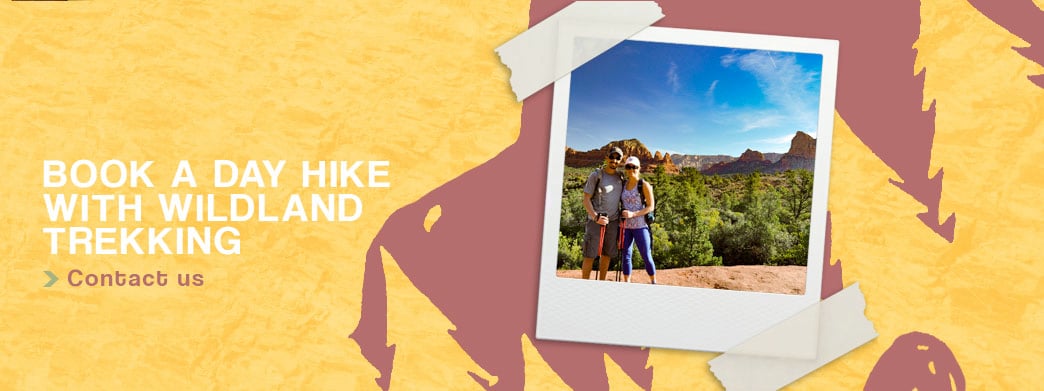What to Do in Grand Canyon in One Day
Learn about what to do and see at Grand Canyon National Park if you only have one day.
The Grand Canyon is an immense natural wonder measuring one mile deep and 1902 square miles in area. As you might imagine, seeing all the canyon has to offer could take weeks. However, as our budgets and busy schedules limit many of us, we often can’t take more than a day to see the park. In this guide, we’ll share some tips and recommendations for seeing the Grand Canyon in one day.
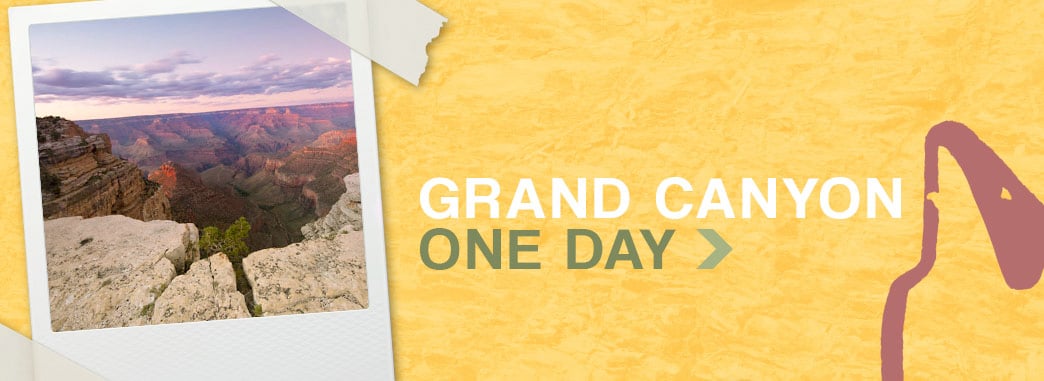
BEST WAY TO SEE THE GRAND CANYON IN ONE DAY
If you’re planning to spend just one day at the Grand Canyon, you’ll need to commit to seeing one of four general areas:
- The West Rim: Also known as Grand Canyon West, the West Rim is just two hours outside of Las Vegas, Nevada. This area is perhaps best known for the Skywalk, a 4000-foot-high glass walkway that extends 70 feet over the canyon’s edge. Other attractions in the area include Guano Point, an abandoned fertilizer mine, and the Hualapai Ranch, where visitors can take horseback rides. It should be noted that the West Rim is located on land owned by the Hualapai Tribe and is not within the boundaries of Grand Canyon National Park, meaning the entrance fees here are separate from those of the park.
- The North Rim: The North Rim is 8000 feet above sea level and offers three viewpoints that show the width rather than the depth of the canyon. The area’s high altitude leads to cooler temperatures and different flora like birch and aspen. In September, visitors can enjoy the vibrant fall colors these trees product. Due to heavy snowfall in the colder months, this area has a relatively short season, which only runs from middle of May to the middle of October. The North Rim is a six-hour drive from Las Vegas and an eight-hour drive from Phoenix.
- The East Rim: Although not officially called the “East Rim,” the eastern portion of the Grand Canyon includes a number of attractions, such as the Little Colorado River Gorge, Marble Canyon and Horseshoe Bend, the last of which offers tourists the unique opportunity to photograph themselves on the Rim with the Colorado River visible behind them.
- The South Rim: Located in the heart of Grand Canyon National Park, The South Rim is often called the “true Grand Canyon,” and its stunning, iconic views are commonly used in movies, television and tourism ads. This area offers more than 20 unique viewpoints, many of which offer views of the Colorado River. This portion of the canyon offers a wide variety of attractions, including popular trails, mule rides, an ancient Indian watchtower and a museum. The South Rim offers many accommodations and services and is open year-round. The area is a five-hour drive from both Las Vegas and Phoenix.
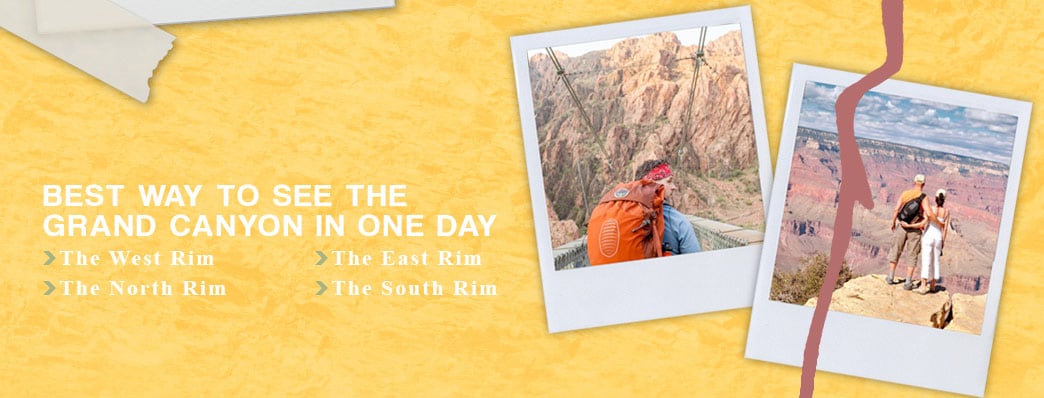
SUNRISE AT THE GRAND CANYON
The Grand Canyon is the country’s second most popular national park, with more than six million tourists visiting every year. While this means certain attractions can get quite crowded, keep in mind that most park visitors don’t rise particularly early. By getting to the park at sunrise, not only will you beat the crowds and find a good parking spot, but you’ll also witness an unforgettable sight: a Grand Canyon sunrise.
Since the South Rim is 7000 feet in elevation, temperatures can be quite chilly — especially at sunrise. Remember to bring along an extra layer.
SOUTH RIM POINTS
The South Rim offers dozens of breathtaking vistas and memorable activities, but as we already mentioned, you can’t see them all in one day. To help you out with planning your itinerary, we’ve selected five attractions you can enjoy on your one-day adventure.
1. MATHER POINT
Located just a short walk from the visitor center, Mather Point is many tourists’ first stop when visiting the park. This panorama offers two overlooks built on top of projecting rocks and, while it can be crowded, you should be able to find some solitude if you venture a short distance out on the Rim Trail. This trail leads to various other attractions on the South Rim, including Yavapai Point and the Yavapai Geological Museum.
2. LIPAN POINT
Lipan Point offers some of the park’s most spectacular views. The walls of the canyon present a tapestry of rich textures and colors, and visitors can also see the Unkar Delta far below, which was farmed by early Native American tribes.
3. DESERT VIEW WATCHTOWER
This curious stone tower was designed to reflect the architectural style of the Ancestral Puebloans. Climb to the top where you can see for more than 100 miles on a clear day. Inside the tower, you can also check out murals painted by Hopi artist Fred Kabotie and buy books and gifts in the Grand Canyon Conservancy shop.
4. TUSAYAN MUSEUM
The Tusayan Ruin and Museum allows visitors to learn about the Puebloan people who lived in the area thousands of years ago and features pottery, arrowheads, corncobs and seashell bracelets.
Just a quarter mile from the museum are ruins from the 12th century that provide a glimpse of how settlers there lived many years ago. It is believed that 16 to 20 settlers lived here at any given time. Although a number of such sites exist in the area, this one is by far the most accessible. There is no charge for admission.
5. YAVAPAI GEOLOGY MUSEUM
Located at the stunning Yavapai Point, the Yavapai Geology Museum offers a variety of experiences including guided tours and hands-on exhibits explaining the region’s geologic history. The museum’s educational exhibits are fun for both children and adults and provide a general understanding of the canyon’s formation.
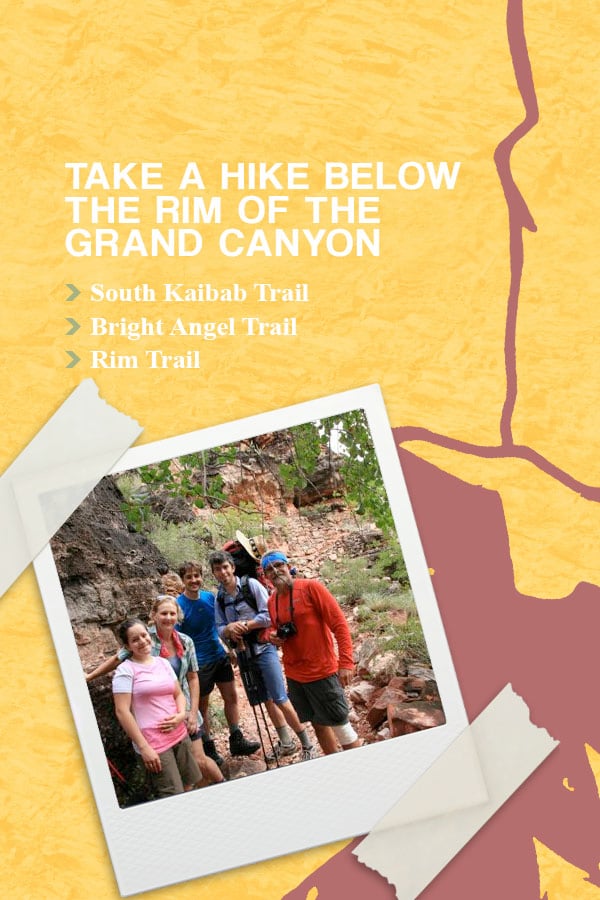
TAKE A HIKE BELOW THE RIM OF THE GRAND CANYON
If you’re up for some adventure and in relatively good shape, consider taking one of the three famous trails below the South Rim. Since most visitors shy away from these trails, they’re a great way to get away from the crowds. Also, hiking Grand Canyon is arguably the best way to experience this amazing national park. Not only do you escape the crowds, but you also step into a world of intimate and meaningful connections with billions of years of geology, expansive views, deep beauty, sheer drops, and amazing cultural history.
Below are the 3 best hiking trails on the South Rim for general visitors. If you’re interested in more adventurous hikes, check out this list of the best Grand Canyon hikes.
Here are the 3 main hiking trails from the South Rim:
1. SOUTH KAIBAB TRAIL
This popular trail descends approximately 5000 feet into the canyon — if you subtract the elevation at the lowest point on the trail (2480 feet) from the highest point (7260 feet) — and allows hikers to take in nearly two billion years of rock history.
The trail starts just to the south of Yaki Point, which you can reach via the shuttle bus. Before starting, make sure to fill your water bottles by the refill station, as there will not be another opportunity for a while. The South Kaibab Trail is known to be one of the fastest and most direct routes to the river. However, as you’re trying to do the Grand Canyon in one day, we recommend that you turn around at Ooh-Ah Point, which is a 1.8-mile round trip.
You will begin on a well-maintained gravel trail and quickly descend into the canyon with several switchbacks. The first notable attraction that you pass is the Kaibab Limestone, the canyon’s youngest exposed rock. After a half mile of tight switchbacking, you arrive at a bench, and the descent becomes more gradual. It is not until you get to Ooh-Ah Point that you experience the first panoramic view on the trail. From here, you can see terraced plateaus on the other side of the canyon.
2. BRIGHT ANGEL TRAIL
If you want a more strenuous physical challenge, you can instead tackle the Bright Angel Trail, the most popular trail that goes from the rim to the river. The path offers breathtaking views, shade, rest houses and water during certain seasons. As you’re only spending one day at the Grand Canyon, we suggest that you turn around at either the Mile-and-a-Half rest house or Three-Mile rest house.
As you go down the Bright Angel Trail, you will pass rock that formed nearly 2 billion years ago. Near the trailhead, you’ll pass by the Kaibab Limestone, which, as mentioned above, is the youngest exposed rock in the canyon. As you descend farther down gentle switchbacks, the rocks you see get older and older. While the Grand Canyon’s many vertical walls make it difficult to create rim-to-river trails, this trail goes along the Bright Angel Fault, which allows visitors to access the inner canyon.
After passing through many sweeping, long switchbacks, you will arrive at the Mile-and-a-Half rest house, which — as you may have guessed — is 1.5 miles from the trailhead. Take some time to rest under the shade and fill up your water bottle. You can also use one of the pit toilets, which are a bit farther down the trail on the right side.
If you feel your energy waning or have many activities left on your itinerary, you may want to turn around here. But if you’ve got time, energy and are interested in seeing even more beautiful views — including the gorgeous, iron-rich Supai Formation and Redwall Limestone — you can proceed to the Three-Mile rest house. This stop also offers water, shade and toilets.
In the Grand Canyon, temperatures can vary widely depending on your elevation and the time of day, so make sure to wear layers.
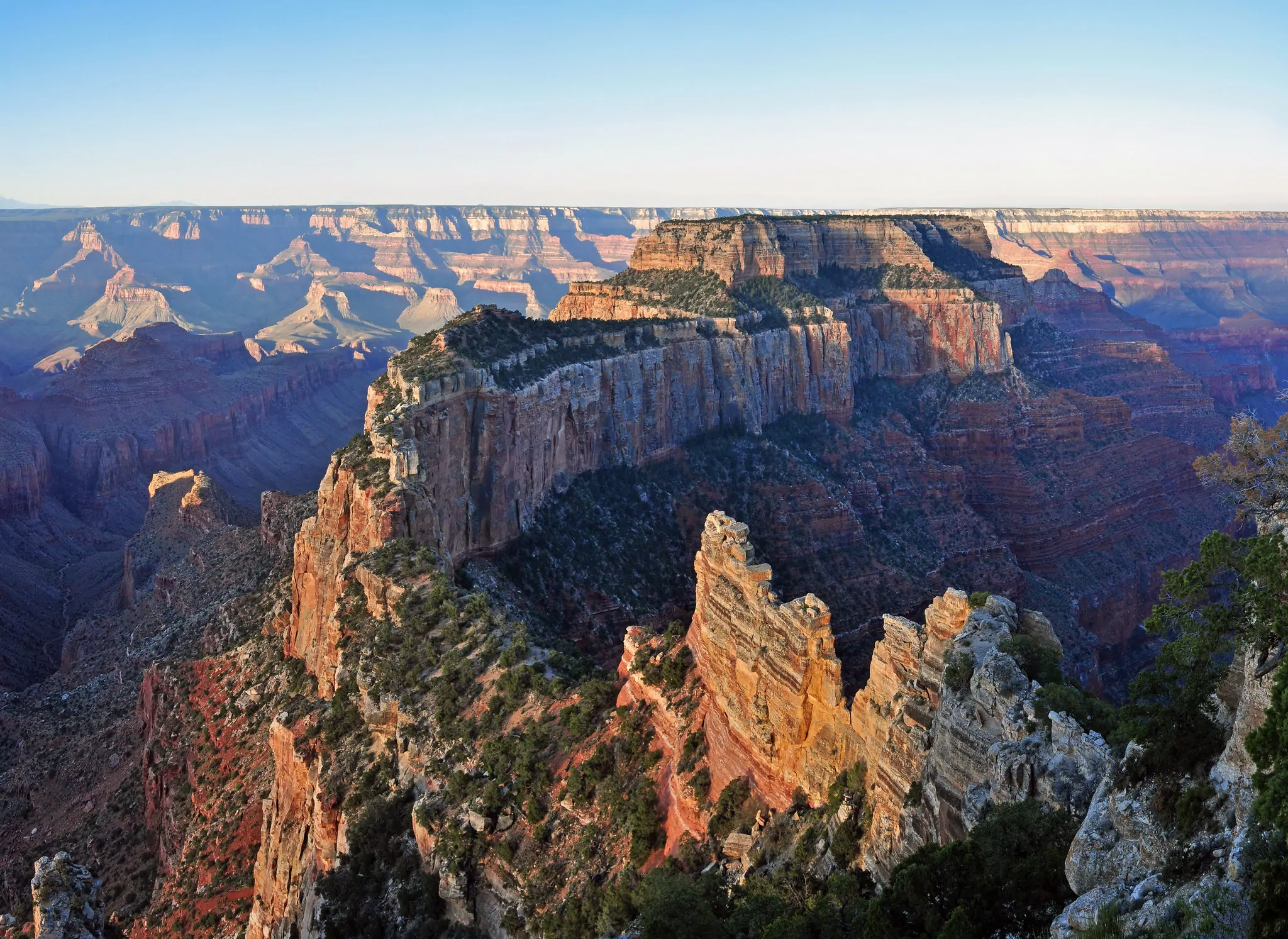
3. RIM TRAIL
If steep descents and endless switchbacks aren’t your thing — or if you’d just like to enjoy the canyon in a more relaxed fashion — you can hike the Rim Trail instead. If you get tired, you can always take the shuttle back.
The 13-mile Rim Trail travels along the edge of the canyon and has more than a dozen shuttle stops along its course, with distances between them ranging from 0.3 to 1.4 miles. This means if your feet or legs start to get tired, you’ll never have to walk too far to catch a shuttle. Certain parts of the trail are accessible to wheelchairs and bikes, and it’s the park’s only trail that allows dogs.
Accessing the Rim Trail is quite simple — take a park shuttle bus, which can be red, blue or orange, to any viewpoint, get off and begin walking. To help you decide which section of the trail you want to hike, here are brief descriptions of each viewpoint:
Stops found along the Red Route are:
- Hermits Rest: This stone building is a National Historic Handmark initially constructed for a railroad. It has a gift shop, snack bar, restrooms, water, picnic tables and vending machines.
- Pima Point: Pima Point offers views of Granite Rapids, the Colorado River and various other stunning geographical features.
- Monument Creek Vista: As you may have guessed from the name, here you can take in excellent views of Monument Creek.
- The Abyss: This dramatic overlook is situated on the edge of a nearly vertical cliff and offers views of Monument Creek and the Colorado River.
- Mojave Point: The section of the Rim Trail between Mojave Point and the Abyss offers magnificent views and many picnic tables, making it a great place to have lunch outside.
- Hopi Point: Hopi Point is considered one of the best places to watch the sunrise or sunset and offers fantastic views of Salt Creek and Hermit Rapids.
- Powell Point: Named for a man who traveled down the Colorado River in 1869, this stop has a monument in his honor.
- Maricopa Point: At Maricopa Point, you can take a look at old equipment used to mine uranium until the late 1960s. The point also offers views of the Plateau Point, located thousands of feet below.
- Trailview Overlook: This stop allows visitors to get a great view of the South Rim Village and the Bright Angel Trail.
The Blue Route has two stops, which are:
- Village Route Transfer/Bright Angel Trailhead: This stop has restrooms and water available. The section of the trail between this stop and the next (Verkamps Visitor Center) has many historic buildings such as El Tovar, Bright Angel Lodge, the Hopi House and the Kolb Studio.
- Verkamp’s Visitor Center: This visitor center offers exhibits, a museum and information about the park.
Stops along the Orange Route include:
- Yavapai Point: The section of the trail between Yavapai Point and Verkamps is called the “Trail of Time,” which displays rocks found inside the Grand Canyon, which are spaced to help visitors grasp the magnitude of geologic time. Tourists who stop here can also visit the Yavapai Geology Museum, which we will talk more about below.
- Mather Point: Located a quick walk from the main visitor center, this point tends to be the park’s most crowded and is most visitors’ first impression of the canyon.
- Pipe Creek Vista: Despite its proximity to Mather Point, Pipe Creek Vista is significantly less crowded and offers beautiful views of the canyon.
- South Kaibab Trailhead: This stop is the beginning of South Kaibab Trail, one of the trails we recommend for your South Rim trip. Water and restrooms are available here.

FOOD AND OTHER ATTRACTIONS
The South Rim offers some great eating options, including Canyon Village Market Place and Deli, Bright Angel Restaraunt and the Yavapai Tavern.
If you’re craving a sweet treat in between meals, make sure to hit up the Bright Angel Fountain, where you can enjoy some refreshing ice cream. The Fountain also sells delicious sandwiches and hot coffee.
BOOK A DAY HIKE WITH WILDLAND TREKKING
When you only have a single day to see this majestic natural wonder, you need to be efficient with your time make sure you see the best things. But if you’re not familiar with the area, you can lose a lot of time just figuring out where to go and how to get there. If you’re an inexperienced hiker without the adequate gear, the experience may be uncomfortable and possibly even dangerous.
At Wildland Trekking, we solve both of these problems by offering all-inclusive Grand Canyon hiking trips, Grand Canyon day hikes, and backpacking trips in the Grand Canyon. We provide the gear, so you won’t have to worry about picking out an appropriate outfit for your expedition. You also won’t waste any time figuring out where to eat, since we provide the meals. Furthermore, you can rest assured you’ll stay safe and won’t get lost, as all our tours are lead by certified hiking guides who adhere to the strictest safety standards. Reach out to use today to plan your Grand Canyon adventure!





